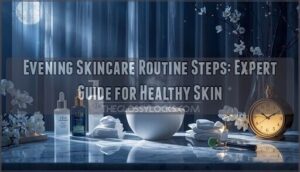This site is supported by our readers. We may earn a commission, at no cost to you, if you purchase through links.

The good news is that rehydrating your skin doesn’t require expensive treatments or complicated routines. By combining internal hydration strategies with targeted topical remedies, you can restore your skin’s moisture balance faster than you might expect.
Table Of Contents
Key Takeaways
- Your skin can lose up to 25% of its moisture-holding capacity in just one hour under harsh conditions, but you can rebuild your moisture barrier by combining internal hydration strategies (drinking water, eating omega-3s and zinc-rich foods, managing stress) with targeted topical remedies like natural oils, humectants, and occlusives.
- Dehydrated skin lacks water while dry skin lacks oils—understanding this difference matters because dehydrated skin responds quickly to hydration changes, whereas dry skin requires lipid-rich products to address sebum deficiency and long-term barrier repair.
- The most effective hydration approach uses a "layering" technique: apply thinnest to thickest products (humectants like hyaluronic acid first, then creams, then occlusives like petroleum jelly) within three minutes after washing to trap moisture when your skin absorbs products best.
- Environmental factors drain hydration faster than most topical damage—maintaining 40-60% indoor humidity, using lukewarm water instead of hot showers, and avoiding over-exfoliation protects your moisture barrier more effectively than adding extra products to your routine.
Why Skin Loses Hydration Quickly
Your skin is like a sponge—it can lose water faster than you might think. Several factors work against your skin’s ability to hold onto moisture, from what you use to wash your face to the air around you.
Understanding what drains hydration helps you protect your skin barrier and keep your complexion healthy.
Causes of Dehydrated Skin
When your skin can’t hold onto water, the culprit often hides in plain sight. Dehydrated skin stems from multiple causes that disrupt barrier function and accelerate transepidermal water loss:
- Environmental factors like UV exposure, cold weather, low humidity, and air pollution damage your skin’s protective layer
- Lifestyle choices including insufficient water intake, alcohol consumption, smoking, and certain medications that increase fluid loss
- Age influences and medical conditions such as hormonal changes, chronic diseases, atopic dermatitis, or side effects from acne treatments that compromise skin hydration
Harsh cleansers strip away essential lipids, while hot water further weakens your moisture barrier. Compromised skin can lead to increased water evaporation, exacerbating dehydration.
Difference Between Dry and Dehydrated Skin
Understanding the difference between dry and dehydrated skin helps you choose the right treatment. Dry skin is a persistent type caused by lipid deficiency and reduced sebum production. Dehydrated skin is temporary, lacking water content but not necessarily oils. You might even have oily yet dehydrated skin simultaneously. Addressing this involves increasing water intake to combat dehydration. Clinical diagnosis uses TEWL rates and skin elasticity tests to distinguish them.
| Dry Skin | Dehydrated Skin |
|---|---|
| Lacks oils and sebum | Lacks water content |
| Persistent flakiness and rough texture | Temporary dullness and fine lines |
| Low ceramide and fatty acid levels | Normal or increased oil with poor water retention |
Environmental and Lifestyle Factors
Your daily habits and surroundings play a bigger role in skin hydration than you might think. Cold air and low humidity outdoors sap moisture from your skin’s surface. Indoors, central heating and pollution effects worsen the problem. Winter skin care becomes challenging when climates impact your moisture barrier daily.
Key factors draining your hydration:
- Sun exposure damages collagen and accelerates water loss
- Stress levels trigger inflammation that weakens your skin barrier
- Sleep quality determines how well your skin repairs overnight
- Low humidity environments pull moisture from deeper skin layers
Using a humidifier helps counteract dry indoor conditions.
Impact of Hot Water and Harsh Cleansers
Hot showers might feel relaxing, but they strip away the natural oils that keep your moisture barrier intact. Water temperature effects matter—hot water damages skin barrier function faster than lukewarm rinses.
Foaming and antibacterial cleansers worsen the problem through harsh cleanser ingredient impact. Choose gentle cleansing alternatives instead.
Overwashing removes protective lipids your skin needs for hydration. Post-wash hydration becomes critical when you can’t avoid these factors.
Hydrating Skin Internally: Diet and Habits
Your skin’s hydration doesn’t start with what you put on it—it starts with what you put in your body. The foods you eat, the water you drink, and even how well you sleep all play a role in keeping your skin plump and healthy.
Here’s how to support your skin from the inside out.
Importance of Drinking Water
When your skin’s outermost layer drops below 30% water content, every cell in your body feels the strain—and drinking enough water is the first line of defense in rebuilding that barrier from the inside out.
Proper water intake aids cellular hydration, which directly improves skin elasticity and helps flush toxins that can dull your complexion.
While ideal dosage varies per person, staying consistently hydrated gives your body the foundation it needs to maintain that plump, healthy glow from within.
Sleep’s Role in Skin Hydration
During those precious 7 to 9 hours of sleep, the skin’s repair mechanisms kick into high gear—rebuilding the moisture barrier, boosting collagen production, and reversing damage that accumulates throughout the day. Sleep quality directly impacts your skin’s ability to retain water and accelerate cell turnover.
Maintaining a consistent sleeping schedule aids:
- Enhanced overnight repair of damaged skin cells
- Strengthened moisture barrier function
- Increased collagen production for plumper skin
- Improved cell regeneration and skin cell health
- Better overall skin hydration levels
Skimping on sleep disrupts these natural processes, leaving your complexion looking dull and dehydrated.
Foods Rich in Healthy Fats and Zinc
Your skin thrives when you fuel it from within—especially with omega-3s and zinc. Fatty fish like salmon and mackerel deliver EPA and DHA that fortify your moisture barrier, while walnuts and flaxseeds provide plant-based omega-3 sources.
For zinc bioavailability, choose oysters, beef, or poultry. Vegetarians can turn to legume hydration benefits from chickpeas and lentils, though absorption is lower.
Pumpkin seeds offer both healthy fats and zinc—a powerful combo for diet and skin health that aids hydration naturally.
Managing Stress for Skin Health
Stress doesn’t just live in your mind—it shows up on your face, breaking down collagen and weakening the moisture barrier that keeps your skin plump and hydrated. When cortisol spikes, inflammation follows, draining moisture and dulling your complexion.
Combat this with mindfulness practices like deep breathing or yoga, which support emotional wellbeing and trigger anti-inflammatory responses. Your skin health depends on managing stress just as much as any serum.
Natural Topical Remedies for Fast Hydration
Your skin doesn’t have to wait days for relief. Natural ingredients you probably already have can deliver fast hydration when your skin needs it most.
Here’s what works and how to use each remedy effectively.
Using Natural Oils (Coconut, Olive, Jojoba, Argan)
Think of natural oils as your skin’s emergency repair crew. Coconut oil, olive oil, and sunflower oil work quickly because their oil absorption rates match your skin’s needs. Jojoba and argan oils are non-comedogenic, meaning they won’t clog pores.
When using natural oils for skin hydration, choose cold-pressed options—extraction methods matter for preserving nutrients. You can even try blending oils to target multiple concerns at once. Just patch-test first to avoid sourcing concerns or reactions.
DIY Hydrating Masks (Avocado, Honey, Aloe Vera)
You probably have everything you need for a hydrating face mask sitting in your kitchen right now. Here are three quick homemade face masks that deliver serious moisture:
- Avocado mask: Mash half an avocado—its antioxidants and probiotics support healthy skin while deeply hydrating.
- Honey mask: Apply raw honey directly for its natural humectant properties that lock in moisture.
- Aloe vera: Smooth the gel on for instant soothing and hydration.
Leave any mask on for 10-15 minutes, then rinse gently with lukewarm water.
Milk Compresses and Tea Bag Applications
If homemade masks aren’t quite cutting it, try two surprisingly effective pantry remedies that work wonders for irritated, dehydrated skin.
Milk compresses offer lactic acid and proteins that calm inflammation—soak a soft cloth in cold milk and apply for 5–10 minutes.
Used tea bags (green or chamomile work best) deliver antioxidants that soothe dry skin while reducing redness. The compress technique is gentle enough for sensitive skin, and you can repeat applications twice daily for maximum relief.
Benefits of Petroleum Jelly and Occlusives
After those quick home remedies, petroleum jelly and similar occlusives deserve special attention for their ability to lock in moisture overnight. These products create a protective seal that reduces transepidermal water loss by up to 99%. Petroleum jelly alleviates dry skin, prevents chafing, and aids healing—this technique, called "slugging," strengthens your skin barrier remarkably well.
- Apply a thin layer after moisturizer to trap hydration while you sleep
- Use on problem areas like elbows and knees for intensive repair
- Try Aquaphor or CeraVe Healing Ointment as effective alternatives
- Expect noticeably softer, plumper skin by morning
Building a Hydrating Skincare Routine
Your skincare routine is just as important as what you eat and drink for keeping your skin hydrated. The right steps can strengthen your moisture barrier and lock in hydration throughout the day.
Here’s how to build a routine that works.
Gentle Cleansing Practices
Choosing the right cleanser can make or break your skin’s ability to hold onto moisture. Skip foaming or antibacterial soaps—they strip away natural oils your skin needs. Instead, opt for mild cleansers that respect your skin’s pH balance. Gentle skin cleansing means washing just once or twice daily to avoid overwashing and skin health problems.
| Cleansing Practice | Why It Matters | Best Approach |
|---|---|---|
| Choose gentle cleansers | Harsh soaps damage moisture barrier | Look for cream or oil-based formulas |
| Oil cleansing | Dissolves impurities without stripping | Massage onto dry skin, rinse gently |
| Limit exfoliation frequency | Over-scrubbing causes irritation | Once or twice weekly maximum |
| Ingredient awareness | Avoid sulfates and alcohol | Check labels for hydrating components |
| Water temperature | Hot water strips protective oils | Use lukewarm water during skin cleansing |
Layering Hydrating Ingredients
Once you’ve nailed down a gentle cleansing routine, the next step is stacking products in the right order so your skin actually absorbs all that hydration.
Apply hydrating ingredients from thinnest to thickest—start with humectants like hyaluronic acid serums, then layer on creams, and seal everything with an occlusive. This "hydration sandwich" technique locks moisture in, maximizing product synergy and keeping your skin care routine effective.
Limiting Hot Showers and Baths
While a steaming shower feels like heaven after a long day, that heat strips away your skin’s natural oils faster than almost anything else. Hot water disrupts your skin barrier, leading to dryness and irritation.
Here’s what to do instead:
- Keep shower temperature lukewarm, not scalding
- Limit bath duration to 5–10 minutes max
- Choose gentle, moisturizing cleansers to reduce soap impact
- Install a filter if water hardness is an issue
- Pat dry and moisturize immediately for proper post-shower care
Incorporating Hydrating Masks and Sleeping Masks
Hydrating masks work like a tall glass of water for your skin—delivering concentrated moisture exactly where you need it most. Look for mask ingredient benefits like hyaluronic acid, which holds 1,000 times its weight in water.
Overnight mask types seal in hydrating ingredients while you sleep, speeding up moisture barrier repair. Apply moisturizer first, then layer your mask twice weekly for best results in your skin care routine.
Preventing and Managing Dry Skin Long-Term
Once you’ve got your skin barrier back on track, keeping it healthy is like maintaining any good habit—it takes consistency and a few smart choices. Your environment, daily routine, and the products you use all play a role in whether your skin stays hydrated or slips back into dryness.
Here’s what you need to focus on to protect your progress and keep your skin comfortable for the long haul.
Moisture Barrier Repair and Protection
Your skin barrier is like a brick wall—when the mortar crumbles, moisture escapes fast. Repairing this protective layer requires strategic ceramide-rich products that restore lipids and fatty acids, which strengthen skin barrier function and reduce transepidermal water loss (TEWL).
When your skin barrier crumbles like mortar, ceramide-rich products rebuild the wall and stop moisture from escaping fast
Here’s how to rebuild your moisture barrier:
- Apply ceramide-dominant moisturizers in a 3:1:1 ratio with cholesterol and fatty acids for measurable skin repair within four weeks.
- Use acidic formulations to boost ceramide content and support ideal enzymatic activity in your chemical barrier.
- Layer occlusives like petroleum jelly over emollients to seal in hydration and reduce TEWL by significant margins.
- Choose products with panthenol and glycerin that upregulate filaggrin and tight junction expression for deeper hydration.
- Support your skin’s microbiome with emollient-rich formulas that increase bacterial diversity and antimicrobial peptide production.
Clinical studies show these approaches improve disease management in conditions like atopic dermatitis and psoriasis, with consumer trends reflecting increased awareness—searches for "skin barrier repair" jumped 29% year-over-year in 2025.
Using Humidifiers and Environmental Adjustments
When indoor humidity drops below 30%, your skin can lose moisture twice as fast as it can naturally replenish it—making environmental adjustments just as critical as the products you apply.
Running a humidifier in your bedroom during winter months helps restore indoor humidity to 40-60%, which reduces transepidermal water loss and relieves winter itch. Cool-mist humidifier types work best for skin health, while keeping room temperature around 68-72°F prevents excessive drying from heating systems.
Daily Moisturizing Techniques
The best moisturizer in the world won’t work if you’re applying it at the wrong time or skipping the steps that lock hydration into your skin. Here’s how to get the most from moisturizers and maintain skin moisture:
- Apply cream within three minutes after washing—your skin absorbs products better when damp
- Layer lightweight hydrators first, then seal with occlusives like petroleum jelly to prevent water loss
- Use gentle massage motions during application to boost circulation and product absorption
This targeted hydration approach strengthens your moisture barrier naturally.
Avoiding Common Skin-Drying Mistakes
Even small daily habits you think are harmless can strip away your skin’s moisture faster than any harsh product. Hot water exposure, over-exfoliating, and skipping moisturizer all damage your skin’s protective barrier. Here’s what to watch for:
| Mistake | Why It Hurts Your Skin | Simple Fix |
|---|---|---|
| Hot Water | Opens pores, strips natural oils | Use lukewarm water for washing |
| Harsh Soap Avoidance ignored | Destroys moisture barrier | Choose gentle, pH-balanced cleansers |
| Overexfoliation | Removes protective skin layers | Limit exfoliation to twice weekly |
| Ignoring Sunscreen | Invites allergens and pollutants damage | Apply SPF 30+ daily |
Frequently Asked Questions (FAQs)
How long does natural skin hydration take?
Natural skin hydration methods work at different speeds—usually days to weeks. Consistency matters more than quick fixes.
Hydrating skin internally through water and diet complements external remedies. Realistic expectations help you stay committed to achieving lasting skin hydration.
Can over-moisturizing damage your skin barrier?
Yes, over-moisturizing can disrupt skin barrier function. Overwashing followed by excessive product application can prevent proper moisture barrier repair, reduce product absorption, and increase skin sensitivity through ingredient interactions, potentially causing long-term effects on your skin’s natural balance.
Which oils work best for oily skin?
For oily skin, jojoba oil works best—it mimics your skin’s natural sebum, helping balance oil production.
Grapeseed and rosehip oils are also lightweight, non-comedogenic options that hydrate without clogging pores.
Do supplements help with dehydrated skin faster?
Certain supplements can strengthen your skin’s foundation like reinforcement beams in a building. Collagen benefits include plumper, hydrated skin, while hyaluronic acid and ceramide supplements support moisture retention. Omega-3s impact inflammation, helping your barrier function better.
Should you hydrate skin differently by season?
Absolutely. Humidity levels drop in winter, so you’ll need heavier occlusives to lock in moisture. Summer’s sun exposure calls for lightweight, protective formulas. Climate impact matters—your skin hydration strategy should shift with the seasons.
Conclusion
Picture your skin cells drinking deeply after a long drought—plump, resilient, and glowing with renewed vitality. That’s what happens when you combine natural ways to hydrate skin quickly from the inside out.
Your skin’s moisture barrier thrives on consistency, not infallibility. By weaving hydrating foods, adequate water intake, and gentle topical remedies into your daily rhythm, you’re not just treating symptoms—you’re rebuilding your skin’s natural defense system.
The difference shows up faster than you’d expect, one replenished cell at a time.
- https://journals.physiology.org/doi/full/10.1152/japplphysiol.00547.2017?rfr_dat=cr_pub++0pubmed&url_ver=Z39.88-2003&rfr_id=ori%3Arid%3Acrossref.org
- https://pmc.ncbi.nlm.nih.gov/articles/PMC11148315/
- https://www.stayskinsafe.com/
- https://www.instagram.com/drdendy/?hl=en
- https://www.aad.org/public/everyday-care/skin-care-secrets/routine/safely-exfoliate-at-home










